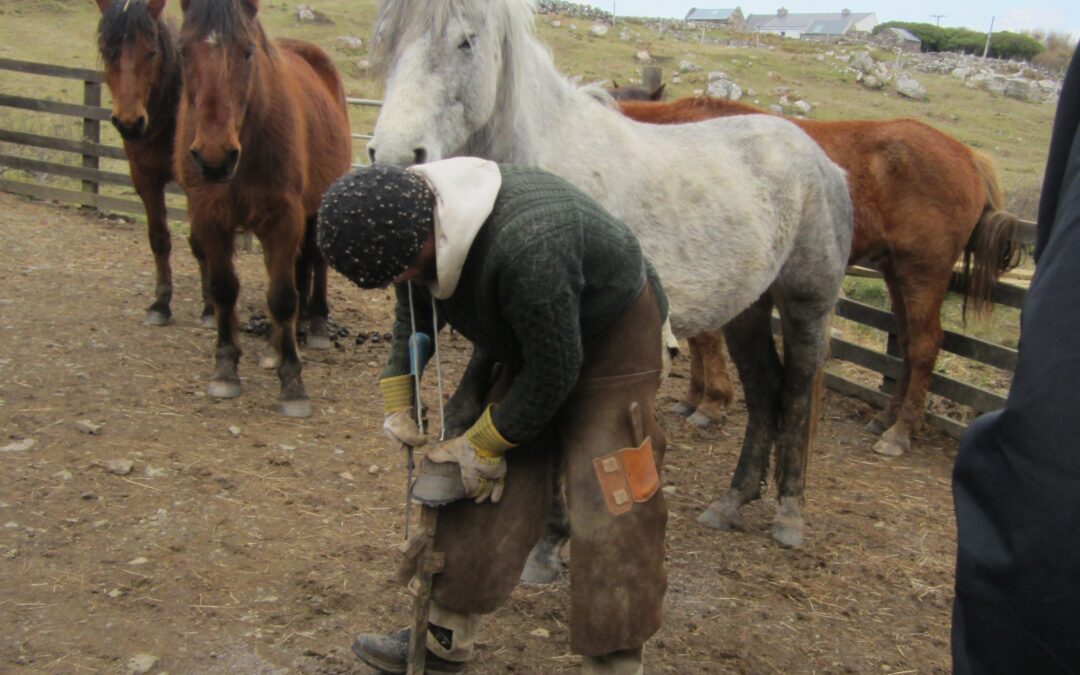A review of our first barefoot trimming workshop
Island life has a way of fostering self-sufficiency.
For me, self-sufficiency in hoof care started on a windy winter morning, when our farrier rang from the harbour on the mainland, saying that, no, he wasn’t coming out to the island after all, as the sea was too rough.
Sinbad and Misty, our two riding horses, had been without shoes for a month at this stage. “When can you come?” I asked wearily. “Well, since I need a full day free to go out to you, it won’t be for another six weeks”. Ten weeks without riding. There had to be a better solution.
That’s when I started to research other options and found out about barefoot trimming.
For years, my horses had been shod because, like most horse owners, I simply didn’t know horses could be ridden without shoes. In my ignorance, I assumed that riding a horse barefoot was cruel, or at best, careless.
But necessity, in this case, turned out to be the mother of education. A bit of research led me to the work of Jaime Jackson and after reading his “Horse Owners Guide to Natural Hoof Care”, I knew that not only I had found the perfect solution to my shoeing problem, but that I would end up with happier, healthier horses.
Shoeing is clearly a specialized skill, but trimming hooves looked more like something that I could master. After all, I am a reasonably competent amateur carpenter, so, as far as I was concerned, with the right tools, I could do it. As well as a set of farrier tools, I got a copy of Peter Ramey’s “Making Natural Hoof Care Work for You”, and a trimming DVD, and I was on my way.
My first attempts at trimming were slow and awkward. The hooves looked OK, much like the ones in the books, but I wasn’t really sure that what I was doing wasn’t hurting the horses, and one of the riding horses was tender on his feet without its shoes. Clearly, there’s only so much you can learn from books and videos. I needed further training.
Unfortunately, looking for a training course proved frustrating. There were none in Ireland, and while I could have travelled to England every month for 2 years and become a qualified equine podiatrist, I could neither spare the time nor the money to do this.
That’s when an internet search lead me to Dermot McCourt’s. Someone in Ireland was doing barefoot trimming! Not only that, but he had been a farrier and had twenty odd years professional experience in hoof care. He had his own system for the management and treatment of laminitis and rotation of the pedal bone, and with this had saved the lives of many horses. It looked like I had found the right man. Luckily, after a couple of phone calls, Dermot agreed to come to the island to trim a few horses and show me how to do it.
Dermot’s first visit to the island was a memorable experience for all involved (including Dermot himself, who ended up travelling back to the mainland at dusk, in rough seas, in a RIB). But within the few hours he had spent on the island, he had managed not only to trim our horses, but to gently point out my trimming mistakes -the toes and the bars left too long, leading to contracted heels and bruised soles -and to show me a few tricks of the trade. Most importantly, he had proven to be hugely competent and extremely generous with his knowledge. The idea of a more formal training course was born, and while it took a while to obtain funding and organise it, this was eventually held on the island in March 2009.
Ten horse owners gathered in the Clare Island community centre bar to listen to Dermot talk about why horses first got shod, why shoes are not necessary, and explain in detail the anatomy of the horse hoof. Then, after a healthy lunch, we all headed out to start trimming.
We had lined up a variety of horses. Mostly Connemara brood mares, of course, as they are the most numerous on the island, but also an Icelandic riding pony, a few of our own riding and draft horses (who regularly work barefoot), and a couple of youngsters. Trimming proved to be the most instructive part of the workshop as we worked our way through a variety of cracked, overgrown or bruised hooves (as well as some healthy feet), under the expert guidance of Dermot and his son John (also a qualified trimmer). By the end of the workshop, we had seen fifteen horses trimmed, everybody had put rasp to hoof, and we all felt a lot more confident about doing it ourselves.
Of course, we are only talking about maintenance trims, not remedial work or shoeing. But with a clear picture in one’s mind of what a healthy hoof should look like, as well as good hooves to start with, it is possible.
More than ten years on, Christophe is still running barefoot trimming workshops although no longer at Macalla farm.
First published in Horse and Pony Ireland


Recent Comments